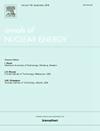离散坐标核反应堆的多群反照率边界条件在X, y矩形几何中的全局计算
IF 1.9
3区 工程技术
Q1 NUCLEAR SCIENCE & TECHNOLOGY
引用次数: 0
摘要
本文研究了利用近似反照率边界条件,在二维笛卡尔几何中数值求解多群离散坐标(SN)中子输运特征值问题,并在均质组装棋盘模型中进行核反应堆全局计算。称为多群反照率矩阵的矩阵算子,通过忽略这些区域内X、y几何多群SN中子输运方程的横向积分所产生的横向泄漏项,近似于核反应堆堆芯(例如挡板和反射器)周围的非相乘区域。这些近似反照率矩阵是通过对粗网格谱Greeńs函数(SGF)方法辅助方程的方便操作得到的,并应用于传统的细网格金刚石差分(DD)方法进行反应器全局计算,目的是通过提供的反照率边界条件代替堆芯周围的非乘法区域,从而缩短计算机运行时间。给出了一个典型的两组模型问题的数值结果,以说明数值结果的准确性和实现该方法的计算机代码的计算机运行时间。本文章由计算机程序翻译,如有差异,请以英文原文为准。
On the multigroup albedo boundary conditions for discrete ordinates nuclear reactor global calculations in X,Y-rectangular geometry
Presented here is a study on the use of approximate albedo boundary conditions, for numerically solving multigroup discrete ordinates (SN) neutron transport eigenvalue problems, in two-dimensional Cartesian geometry for nuclear reactor global calculations in homogenized assembly chessboard models. A matrix operator, referred to as multigroup albedo matrix, approximates the non-multiplying regions that typically surround the cores of nuclear reactors (e.g., baffle and reflector), by neglecting the transverse leakage terms that arise from transverse integrations of the X, Y-geometry multigroup SN neutron transport equations within these regions. These approximate albedo matrices are obtained through convenient manipulations of the coarse-mesh Spectral Greeńs Function (SGF) method’s auxiliary equations and are applied to the traditional fine-mesh Diamond Difference (DD) method in reactor global calculations, aiming at shortening the computer running time by substituting the non-multiplying regions around the core through the offered albedo boundary conditions. Numerical results are provided for one typical two-group model problem to illustrate the accuracy of the numerical results and computer running time of the computer code implementing the proposed approach.
求助全文
通过发布文献求助,成功后即可免费获取论文全文。
去求助
来源期刊

Annals of Nuclear Energy
工程技术-核科学技术
CiteScore
4.30
自引率
21.10%
发文量
632
审稿时长
7.3 months
期刊介绍:
Annals of Nuclear Energy provides an international medium for the communication of original research, ideas and developments in all areas of the field of nuclear energy science and technology. Its scope embraces nuclear fuel reserves, fuel cycles and cost, materials, processing, system and component technology (fission only), design and optimization, direct conversion of nuclear energy sources, environmental control, reactor physics, heat transfer and fluid dynamics, structural analysis, fuel management, future developments, nuclear fuel and safety, nuclear aerosol, neutron physics, computer technology (both software and hardware), risk assessment, radioactive waste disposal and reactor thermal hydraulics. Papers submitted to Annals need to demonstrate a clear link to nuclear power generation/nuclear engineering. Papers which deal with pure nuclear physics, pure health physics, imaging, or attenuation and shielding properties of concretes and various geological materials are not within the scope of the journal. Also, papers that deal with policy or economics are not within the scope of the journal.
 求助内容:
求助内容: 应助结果提醒方式:
应助结果提醒方式:


